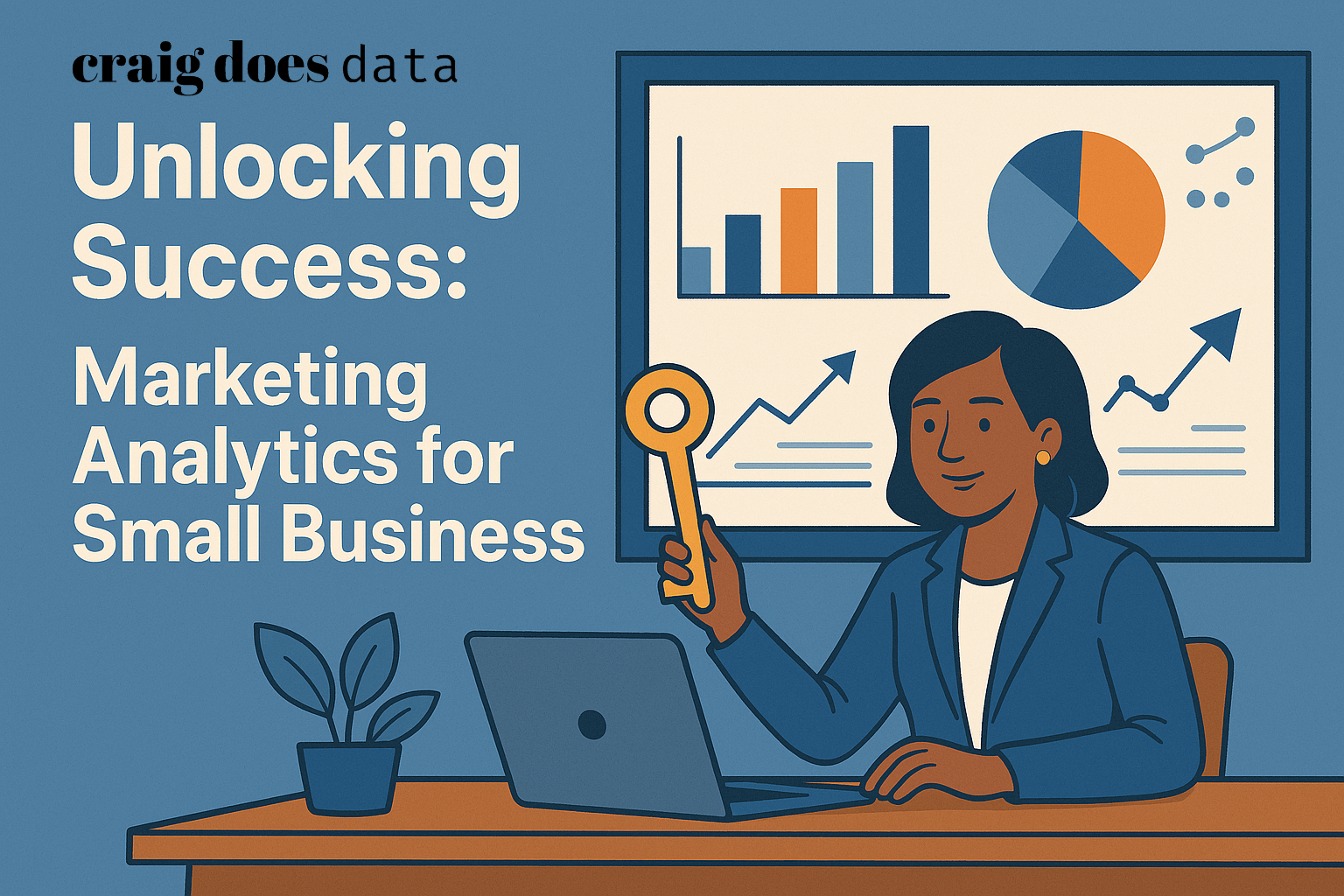
Unlocking Success: A Comprehensive Guide to Marketing Analytics for Small Business
In today’s dynamic business landscape, data isn't just a buzzword; it's the compass guiding businesses toward sustainable growth and profitability. For small businesses, often operating with limited resources and tighter margins, leveraging data-driven strategies is no longer a luxury—it's a necessity for survival and thriving. Imagine making crucial marketing decisions based on hunches or gut feelings alone. In a competitive market, this approach is akin to navigating a ship without a map or a compass. This is where marketing analytics steps in, transforming raw data into actionable insights that can dramatically improve your marketing ROI and overall business performance.
This guide is crafted specifically for small business owners, marketing managers, and anyone eager to understand and implement marketing analytics effectively. We aim to demystify the world of data and analytics, breaking down complex concepts into digestible, practical steps. Whether you're just starting out or looking to refine your existing marketing efforts, this comprehensive resource will equip you with the knowledge and tools to harness the power of marketing analytics. We'll explore how to set up your analytics framework, collect and manage essential data, interpret that data to uncover hidden opportunities, and apply these insights to optimize your marketing campaigns for maximum impact.
Over the following sections, we'll journey through the core components of marketing analytics, tailored for the unique needs and challenges of small businesses. We'll begin by defining what marketing analytics truly is and why it's indispensable for small business success. Then, we’ll move into the practical aspects of setting up your analytics infrastructure, identifying key performance indicators (KPIs), and selecting the right tools for your business needs. We will delve into data collection best practices, address common pitfalls, and guide you through the process of transforming data into meaningful insights using visualization techniques and real-world case studies. Finally, we’ll discuss how to apply these insights to optimize your marketing campaigns, personalize customer experiences, and stay ahead of the curve by keeping up with the latest trends and innovations in marketing analytics.
Our goal is to empower you to make informed, strategic decisions, moving away from guesswork and towards data-backed confidence. By the end of this guide, you will not only understand the ‘what’ and ‘why’ of marketing analytics but, more importantly, the ‘how’ – how to implement it in your small business to drive growth, enhance customer engagement, and achieve your business objectives. Let's embark on this journey together and unlock the immense potential of marketing analytics for your small business.
1. Understanding Marketing Analytics

Marketing analytics is essentially the process of measuring, managing, and analyzing marketing performance to maximize its effectiveness and optimize return on investment (ROI). For small businesses, this is particularly crucial as every marketing dollar needs to be spent wisely. It’s about moving beyond simply ‘doing marketing’ to understanding ‘what marketing works,’ ‘why it works,’ and ‘how to make it work even better.’ At its core, marketing analytics uses data to answer critical questions about your marketing efforts, providing a clear picture of what’s happening and why.
Why is marketing analytics so important for small businesses? Firstly, it provides concrete evidence rather than assumptions. Instead of guessing whether your latest social media campaign is effective, analytics can show you exactly how many people saw your posts, how many clicked on your links, and ultimately, how many converted into customers. This data-driven approach eliminates guesswork and allows you to focus on strategies that are proven to deliver results. Secondly, marketing analytics helps you understand your customers better. By analyzing data from various touchpoints – your website, social media, email campaigns, and customer interactions – you can gain valuable insights into customer behavior, preferences, and pain points. This deeper understanding allows you to tailor your marketing messages and offers to resonate more effectively with your target audience, leading to higher engagement and conversion rates.
Moreover, in today’s digital age, customers interact with businesses across multiple channels. Marketing analytics helps you track and understand these multi-channel journeys. For example, a customer might discover your product through a social media ad, visit your website, sign up for your email list, and finally make a purchase after receiving a promotional email. Without analytics, it's difficult to see this complete journey and attribute the final sale to the initial touchpoint. Marketing analytics tools provide a holistic view of customer interactions, allowing you to optimize each touchpoint and create a seamless, effective customer journey. This is especially important for small businesses looking to build strong customer relationships and foster loyalty.
The role of marketing analytics in decision-making cannot be overstated. Imagine you're deciding between investing more in social media ads or email marketing. Without analytics, this decision might be based on industry trends or competitor actions, which may not be directly relevant to your specific business and audience. However, with marketing analytics, you can review the performance of your past social media and email campaigns. You can compare metrics like engagement rates, click-through rates, conversion rates, and cost per acquisition for both channels. This data allows you to make an informed decision, allocating your marketing budget to the channel that has historically delivered the best results for your business. This level of precision is invaluable for small businesses aiming to maximize their marketing impact with limited resources. Ultimately, understanding marketing analytics is the first step towards transforming your marketing from a cost center into a powerful engine for growth and profitability.
2. Setting Up Your Analytics Framework

Setting up an effective analytics framework is the foundation of data-driven marketing for any small business. It's about establishing a structured approach to measure, track, and analyze your marketing efforts. This framework helps you to move from simply collecting data to using data strategically to achieve your business goals. The process begins with identifying the key metrics that truly matter to your business, choosing the right tools to track these metrics, and finally, integrating analytics into your overall marketing strategy. Let’s break down each of these crucial steps.
Identifying key metrics is the first and most important step in setting up your analytics framework. These metrics, often referred to as Key Performance Indicators (KPIs), are the vital signs of your marketing health. They should directly reflect your business objectives. For example, if your primary business goal is to increase online sales, relevant KPIs might include website conversion rate, average order value, customer acquisition cost (CAC), and revenue per visitor. If your goal is to build brand awareness, KPIs could be website traffic, social media engagement (likes, shares, comments), brand mentions, and reach. It’s crucial to align your KPIs with your specific business goals. Generic metrics like ‘total website visits’ might sound impressive, but if they don’t directly contribute to your business objectives, they're essentially vanity metrics. Instead, focus on metrics that are actionable and directly tied to your desired outcomes. Start by asking yourself: "What does success look like for my business?" and then identify the metrics that will help you measure progress towards that success.
Once you've identified your key metrics, the next step is to select the right tools and platforms to track them. Fortunately, there are many powerful and affordable analytics tools available, even for small businesses with limited budgets. Google Analytics is arguably the most popular and widely used free web analytics platform. It provides a wealth of data about your website traffic, user behavior, conversion tracking, and much more. For social media analytics, platforms like Facebook Insights and LinkedIn Analytics offer built-in dashboards to track engagement, reach, and audience demographics for your social media efforts. For email marketing, platforms like Mailchimp, Kit (formerly ConvertKit), and ActiveCampaign provide detailed analytics on open rates, click-through rates, conversion rates, and subscriber behavior. Beyond these free or platform-specific tools, there are also comprehensive marketing analytics platforms like HubSpot, SEMrush, and Moz that offer a wider range of features, including SEO analysis, content marketing analytics, and competitive analysis. For small businesses starting out, Google Analytics and the built-in analytics of social media and email platforms are excellent starting points. They provide a robust set of features to track your key metrics without requiring a significant investment. As your business grows and your analytics needs become more sophisticated, you can explore more advanced and integrated platforms.
Finally, integrating analytics into your marketing strategy is about making data a central part of your marketing process, not just an afterthought. It means building a marketing strategy that is informed by data from the outset. For example, before launching a new marketing campaign, review historical data to understand what types of campaigns have performed well in the past, which channels have been most effective, and what customer segments have been most responsive. Use analytics to set realistic and data-backed goals for your new campaign. During the campaign, continuously monitor your KPIs to track performance in real-time. If you notice that certain aspects of the campaign are underperforming, use analytics to diagnose the issues and make data-driven adjustments on the fly. After the campaign concludes, conduct a thorough post-campaign analysis to evaluate its overall effectiveness, identify what worked well and what didn’t, and gather insights for future campaigns. This iterative process of planning, executing, monitoring, and analyzing based on data is the essence of integrating analytics into your marketing strategy. It transforms your marketing efforts from reactive to proactive, from guesswork to informed decisions, and ultimately, from hoping for results to strategically driving them. By setting up a solid analytics framework, you lay the groundwork for continuous improvement and sustainable marketing success for your small business.
3. Collecting and Managing Data

Effective marketing analytics hinges on the quality and management of your data. Collecting the right types of data, ensuring its accuracy and ethical collection, and overcoming common data collection challenges are crucial steps in building a reliable analytics foundation for your small business. Understanding the different types of data and adopting best practices for data collection will set you up for insightful analysis and informed decision-making.
When it comes to marketing analytics, data broadly falls into two categories: quantitative and qualitative. Quantitative data is numerical and measurable. It tells you ‘what’ is happening and ‘how much.’ Examples include website traffic, conversion rates, sales revenue, click-through rates, and customer demographics. This type of data is objective and can be statistically analyzed to identify trends, patterns, and correlations. Qualitative data, on the other hand, is descriptive and provides insights into ‘why’ things are happening. It’s about understanding the context, opinions, and motivations behind customer behavior. Examples include customer feedback, survey responses, reviews, social media comments, and open-ended survey questions. Qualitative data offers rich insights into customer sentiment, preferences, and pain points, which can be invaluable for understanding the ‘why’ behind the ‘what’ revealed by quantitative data. For a holistic understanding of your marketing performance, it’s essential to leverage both quantitative and qualitative data. Quantitative data provides the numbers and metrics to track performance, while qualitative data adds depth and context, helping you understand the stories behind the numbers. For instance, a drop in website conversion rates (quantitative data) might prompt you to analyze customer feedback and reviews (qualitative data) to understand why conversions are declining. Perhaps customers are finding the checkout process confusing, or they are expressing dissatisfaction with product descriptions. Combining both types of data provides a more complete and actionable picture.
Best practices for data collection are paramount to ensure the reliability and ethical integrity of your marketing analytics. Firstly, always prioritize ethical data collection and respect customer privacy. Be transparent about what data you are collecting and how you will use it. Obtain consent when necessary, especially for personal data. Comply with data privacy regulations like GDPR and CCPA, which mandate how businesses collect and handle personal data. Secondly, ensure data accuracy and quality. Implement data validation processes to minimize errors and inconsistencies. Use reliable data sources and tools. Regularly audit your data collection processes to identify and rectify any issues. Inaccurate data can lead to misleading analysis and flawed decisions, so data quality is non-negotiable. Thirdly, automate data collection wherever possible to improve efficiency and reduce manual errors. Utilize analytics tools that automatically track website traffic, social media engagement, and email marketing metrics. Integrate your marketing platforms with your analytics tools to streamline data flow. Automation not only saves time but also ensures consistent and timely data collection. Finally, document your data collection processes. Maintain clear records of what data is collected, how it is collected, where it is stored, and who has access to it. This documentation is essential for data governance, compliance, and ensuring consistency over time, especially as your business grows and your team evolves.
Small businesses often face unique challenges in data collection. Limited technical expertise can be a barrier. Many small business owners might not be tech-savvy or have dedicated IT staff to set up complex data collection systems. The solution here is to leverage user-friendly analytics tools that are designed for non-technical users. Platforms like Google Analytics offer straightforward setup processes and intuitive interfaces. Many marketing platforms also provide easy-to-use analytics dashboards. Time constraints are another common challenge. Small business owners are often juggling multiple roles and might not have dedicated time to focus on data collection. Prioritize collecting data that is most relevant to your key metrics and business goals. Start with tracking a few essential KPIs rather than trying to collect everything at once. Focus on automating data collection to save time. Budget limitations can also be a concern. While many excellent free analytics tools are available, some advanced features or comprehensive platforms might come with a cost. Start with free tools and gradually explore paid options as your business grows and your budget allows. Consider the ROI of paid tools – if they can significantly improve your marketing performance and drive revenue, they can be a worthwhile investment. Lastly, data silos can be a challenge, especially if different marketing activities are managed using disparate tools that don’t integrate well. Aim to use integrated marketing platforms that can centralize your data collection and provide a unified view of your marketing performance. If full integration is not immediately feasible, explore data connectors or APIs that can help you bring data from different sources together for analysis. By understanding these challenges and adopting practical solutions, small businesses can effectively collect and manage data to fuel their marketing analytics efforts.
4. Analyzing and Interpreting Data

Collecting data is only half the battle. The real power of marketing analytics lies in your ability to analyze and interpret that data to extract actionable insights. This process involves transforming raw numbers and metrics into meaningful understandings that can guide your marketing decisions and strategies. It’s about going beyond just reporting what happened to understanding why it happened and what you can do about it. Turning data into insights requires a systematic approach, effective data visualization, and practical application of analytical thinking.
Turning raw data into actionable insights is a multi-step process. Start with cleaning and organizing your data. Raw data is often messy, incomplete, or inconsistent. Data cleaning involves removing errors, handling missing values, and standardizing formats to ensure data accuracy and consistency. Organize your data in a structured format, such as spreadsheets or databases, to facilitate analysis. Next, identify patterns and trends. Look for recurring patterns, significant trends, and notable outliers in your data. For example, are website traffic spikes consistently observed on certain days of the week? Is there a trend of increasing social media engagement over time? Are there any unusual drops or spikes in conversion rates? Tools like spreadsheet software (e.g., Excel, Google Sheets) or data analysis platforms can help you identify these patterns. Then, seek to understand the ‘why’ behind the patterns. Correlation does not equal causation. Just because two metrics move together doesn’t mean one causes the other. Dig deeper to understand the underlying reasons for observed patterns. For example, if you see a spike in website traffic after launching a social media campaign, investigate further to confirm if the social media campaign directly drove the traffic increase. Analyze qualitative data, such as customer feedback, to gain deeper insights into customer motivations and behaviors. Finally, translate insights into actionable recommendations. Insights are only valuable if they lead to action. Based on your analysis, formulate clear and specific recommendations for improving your marketing efforts. For example, if you find that mobile website traffic has a high bounce rate, the actionable recommendation might be to optimize your website for mobile devices. Ensure your recommendations are practical, measurable, and aligned with your business goals. This iterative process of data cleaning, pattern identification, understanding causes, and formulating recommendations is key to turning data into valuable, actionable insights.
Data visualization plays a critical role in simplifying data interpretation and making insights more accessible and understandable. Visualizations transform complex data sets into visual formats like charts, graphs, and dashboards, making it easier to spot trends, patterns, and anomalies. Choose the right type of visualization for your data. Bar charts are excellent for comparing categories, line graphs are ideal for showing trends over time, and scatter plots can reveal correlations between variables. Select visualizations that effectively communicate the key insights you want to convey. Keep visualizations clear and simple. Avoid clutter and unnecessary complexity. Use clear labels, titles, and legends. Choose colors and fonts that enhance readability. The goal is to make your visualizations easy to understand at a glance, even for those who are not data experts. Use dashboards to monitor key metrics in real-time. Dashboards aggregate multiple visualizations into a single view, providing a snapshot of your marketing performance. Tools like Google's Looker Studio, Tableau, and Power BI allow you to create interactive dashboards that automatically update with new data. Dashboards enable you to track your KPIs continuously and identify potential issues or opportunities quickly. Tell a story with your visualizations. Effective data visualization is not just about presenting data; it’s about telling a compelling story. Use annotations, captions, and narrative text to explain the insights revealed by your visualizations and guide your audience to the key takeaways. Visualizations should not just show data; they should communicate insights and drive action. By effectively using data visualization tools and techniques, you can make data interpretation more efficient, insightful, and impactful for your small business.
Let’s look at a couple of hypothetical case studies to illustrate how small businesses have successfully used marketing analytics to improve their strategies.
Case Study 1: Local Coffee Shop – Optimizing Social Media Marketing A local coffee shop noticed that their social media engagement was low despite consistent posting. They started using social media analytics tools (like Facebook Insights and Instagram Insights) to analyze their post performance. They tracked metrics like reach, engagement rate (likes, comments, shares), and website clicks from social media. Analysis revealed that posts with high-quality images of coffee and pastries performed significantly better than text-based posts or generic promotional posts. They also discovered that posts in the evening and on weekends had higher engagement rates. Insight: Visual content and timing matter significantly for their social media audience. Action: The coffee shop shifted their social media strategy to focus on visually appealing content, posting high-quality photos and videos of their products. They also scheduled their posts to coincide with peak engagement times in the evenings and weekends. Result: Within a month, they saw a 40% increase in social media engagement, a 20% increase in website traffic from social media, and a noticeable uptick in foot traffic to their shop, attributed to increased brand visibility on social media.
Case Study 2: Online Boutique – Improving Website Conversion Rates
An online boutique selling handmade jewelry was experiencing decent website traffic but low conversion rates. They used Google Analytics to analyze website user behavior. They focused on metrics like bounce rate, pages per session, session duration, and conversion rate. Analysis showed that the product pages had a high bounce rate and low session duration, indicating that visitors were leaving product pages quickly without making a purchase. They also noticed that mobile conversion rates were significantly lower than desktop conversion rates. Insight: Product pages were not effectively engaging visitors, especially mobile users. Action: The boutique redesigned their product pages, focusing on high-quality product images, detailed product descriptions, customer reviews, and clear call-to-action buttons. They also optimized their website for mobile responsiveness to improve the mobile user experience. Result: After redesigning their product pages and optimizing for mobile, they saw a 60% decrease in bounce rate on product pages, a 30% increase in session duration, and a 25% increase in overall website conversion rates within two months.
These case studies demonstrate that even simple marketing analytics, when applied systematically and intelligently, can yield significant improvements in marketing performance for small businesses. By analyzing data, extracting insights, and taking data-driven actions, these businesses were able to optimize their strategies and achieve tangible results.
5. Applying Insights to Improve Marketing Efforts

The ultimate goal of marketing analytics is not just to understand data, but to use those insights to improve your marketing efforts and drive better results. This involves optimizing your marketing campaigns, refining your targeting and personalization strategies, and establishing methods to measure the success of your improvements. Applying insights effectively closes the loop in the analytics process, turning data-driven understanding into tangible marketing outcomes.
Optimizing marketing campaigns based on analytics insights is about continuous improvement and iterative refinement. One of the most powerful techniques for campaign optimization is A/B testing. Use data to identify areas for improvement in your marketing campaigns, such as ad copy, landing page design, email subject lines, or call-to-action buttons. Create two versions (A and B) of the element you want to test, with only one variable changed. For example, test two different versions of an ad headline. Run the A/B test, showing version A to one segment of your audience and version B to another segment. Use analytics to track the performance of each version, focusing on metrics like click-through rates, conversion rates, or engagement rates. Determine which version performs better based on the data. Implement the winning version in your marketing campaign and iterate. A/B testing is an ongoing process. Continuously test different elements of your campaigns to identify what resonates best with your audience and optimize for better performance over time. Beyond A/B testing, use analytics to monitor campaign performance in real-time. Track KPIs like campaign reach, engagement, website traffic, leads generated, and conversions. If you notice that a campaign is underperforming, use analytics to diagnose the issues. Are click-through rates low? Is the landing page bounce rate high? Are conversions not happening? Based on the diagnosis, make data-driven adjustments to your campaign. For example, if click-through rates are low, refine your ad targeting or ad creative. If landing page bounce rates are high, improve the landing page design and content. Regular monitoring and data-driven adjustments ensure that your campaigns are continuously optimized for maximum effectiveness.
Analytics plays a crucial role in refining your targeting and personalization efforts. Use data to identify your target audiences more precisely. Analyze customer demographics, psychographics, behavior patterns, and purchase history to segment your audience into distinct groups. Tools like CRM systems, customer data platforms (CDPs), and analytics platforms can help you segment your audience based on various criteria. Understand the needs, preferences, and pain points of each segment. Analytics can reveal what motivates different segments of your audience, what channels they prefer, what type of messaging resonates with them, and what products or services they are most interested in. Use this understanding to tailor your marketing messages and offers for each segment. Personalization is key to effective marketing. Instead of sending generic marketing messages to everyone, use data to personalize the content, offers, and timing of your communications for each segment or even individual customer. For example, personalize email marketing campaigns based on customer purchase history or website behavior. Personalize website content based on visitor demographics or browsing history. Personalized marketing messages are more relevant, engaging, and effective in driving conversions. Analytics can also help you optimize your channel selection. Analyze which marketing channels (social media, email, search ads, content marketing, etc.) are most effective in reaching and engaging different segments of your audience. Allocate your marketing budget and efforts to the channels that deliver the best results for each segment. For example, if you find that social media is highly effective in reaching younger demographics, focus more social media marketing efforts on this segment. Data-driven targeting and personalization ensure that your marketing efforts are more efficient, relevant, and impactful, leading to higher ROI and improved customer relationships.
Measuring the success of your marketing efforts through analytics is essential to validate your strategies and demonstrate ROI. Establish clear metrics for success before launching any marketing initiative. These metrics should be aligned with your campaign objectives and overall business goals. For example, if your objective is to increase brand awareness, success metrics might include reach, impressions, social media engagement, and website traffic. If your objective is to drive sales, success metrics might include conversion rates, sales revenue, average order value, and customer acquisition cost. Track your chosen success metrics throughout your marketing efforts and after completion. Use analytics dashboards and reporting tools to monitor performance against your set metrics. Regularly report on your marketing performance to stakeholders, demonstrating the impact of your efforts and the ROI of your marketing investments. Use data to demonstrate successes and identify areas for improvement. Calculate your marketing ROI to understand the profitability of your marketing initiatives. A positive ROI indicates that your marketing efforts are generating more revenue than they cost. Use ROI data to optimize your marketing budget allocation and justify future marketing investments. Continuously refine your measurement methods and success metrics as your business evolves and your marketing strategies become more sophisticated. Regularly review your metrics, dashboards, and reporting processes to ensure they are still relevant and effective in measuring your marketing success. By establishing clear success metrics, tracking performance, and calculating ROI, you can demonstrate the value of marketing analytics, optimize your marketing efforts, and drive sustainable growth for your small business.
6. Staying Up-to-Date with Trends and Innovations

The field of marketing analytics is constantly evolving, driven by technological advancements and changing consumer behaviors. Staying up-to-date with emerging tools, technologies, and future trends is crucial for small businesses to maintain a competitive edge and continue to leverage marketing analytics effectively. Continuous learning and adaptation are not just beneficial; they are essential for long-term success in the dynamic world of digital marketing.
Emerging tools and technologies are continually reshaping the landscape of marketing analytics. Artificial intelligence (AI) and machine learning (ML) are increasingly being integrated into analytics platforms, offering advanced capabilities like predictive analytics, automated insights generation, and personalized customer experiences. AI-powered tools can analyze vast datasets, identify complex patterns, and provide insights that would be difficult for humans to uncover manually. Marketing automation platforms are becoming more sophisticated, integrating analytics to optimize campaign workflows, personalize customer journeys, and automate data-driven decisions. These platforms streamline marketing processes and enhance efficiency. Customer Data Platforms (CDPs) are gaining prominence as central hubs for collecting, unifying, and activating customer data from various sources. CDPs provide a holistic view of the customer, enabling more personalized and data-driven marketing efforts. Advanced data visualization tools are evolving, offering more interactive and insightful ways to present data. Tools that incorporate augmented reality (AR) and virtual reality (VR) are starting to emerge, potentially offering immersive data experiences in the future. Voice analytics and natural language processing (NLP) are becoming more relevant as voice search and voice assistants gain popularity. Analyzing voice data can provide new insights into customer preferences and behaviors. For small businesses, it’s important to stay informed about these emerging tools and technologies and explore how they can be leveraged to enhance their marketing analytics capabilities, improve efficiency, and gain a competitive advantage. Starting with free or freemium versions of new tools and gradually adopting more advanced solutions as needed can be a practical approach for small businesses.
Several future trends are poised to significantly impact marketing analytics. Privacy-focused analytics is becoming increasingly important as data privacy regulations tighten and consumer awareness of data privacy grows. The future of analytics will likely emphasize privacy-preserving techniques and ethical data handling. Cookieless tracking is emerging as a response to browser privacy updates and the phasing out of third-party cookies. Marketers will need to adapt to new tracking methods that rely on first-party data, contextual data, and privacy-friendly technologies. The increasing importance of first-party data means that small businesses need to focus on building direct relationships with their customers and collecting data directly from them. First-party data is more valuable and sustainable in a privacy-conscious world. The integration of online and offline data will become more seamless. Businesses will strive to create a unified view of customer interactions across both online and offline channels to gain a comprehensive understanding of the customer journey. Predictive analytics will become more mainstream, empowering marketers to forecast future trends, anticipate customer needs, and proactively optimize marketing strategies. The demand for real-time analytics will continue to grow as businesses seek to react faster to market changes and customer behaviors. Real-time data and insights will enable more agile and responsive marketing. Small businesses should pay attention to these future trends and start preparing for these shifts in the marketing analytics landscape. Adapting to privacy-focused analytics, exploring cookieless tracking solutions, prioritizing first-party data collection, and embracing predictive analytics will be key strategies for future-proofing their marketing analytics efforts.
Continuous learning and adaptation are essential for staying ahead in the ever-evolving field of marketing analytics. Make learning a regular part of your routine. Dedicate time each week or month to learn about new trends, tools, and techniques in marketing analytics. Follow industry blogs, publications, and influencers. Subscribe to marketing analytics blogs, newsletters, and podcasts to stay informed about the latest developments. Attend webinars and online events. Many marketing analytics platforms and industry experts offer free webinars and online events that provide valuable insights and training. Take online courses and certifications. Platforms like Coursera, Udemy, and LinkedIn Learning offer courses on marketing analytics, data science, and related topics. Consider pursuing certifications to validate your skills and knowledge. Join online communities and forums. Engage with other marketing professionals and analytics experts in online communities and forums to exchange ideas, ask questions, and learn from each other. Experiment with new tools and techniques. Don’t be afraid to try out new analytics tools and techniques, even if they are outside your comfort zone. Start with free trials or freemium versions to explore their potential. Adapt your strategies based on new learnings and trends. Continuously evaluate your marketing analytics strategies and be willing to adapt them based on new insights, trends, and technologies. Agility and adaptability are crucial for staying competitive in the fast-paced world of marketing analytics. By embracing continuous learning and proactively adapting to change, small businesses can ensure that their marketing analytics efforts remain effective, innovative, and aligned with the evolving market landscape.
Conclusion
Marketing analytics is no longer a luxury but a fundamental necessity for small businesses aiming to thrive in today’s competitive market. This comprehensive guide has explored the essential aspects of marketing analytics, from understanding its importance and setting up a framework to collecting and analyzing data, applying insights, and staying updated with the latest trends. By embracing data-driven strategies, small businesses can move away from guesswork and intuition towards informed decision-making, leading to more effective marketing campaigns, improved customer engagement, and sustainable business growth.
We’ve emphasized the importance of identifying key metrics aligned with business goals, selecting the right tools, and integrating analytics into the overall marketing strategy. We’ve delved into the types of data, best practices for ethical and accurate data collection, and solutions to common data collection challenges faced by small businesses. The guide has highlighted the process of transforming raw data into actionable insights through analysis and visualization, and illustrated with case studies how small businesses can leverage these insights to optimize social media marketing and website conversion rates. Furthermore, we’ve discussed how to apply insights to improve marketing campaigns, refine targeting and personalization, and measure success effectively. Finally, we underscored the significance of continuous learning and adaptation to stay abreast of emerging tools, technologies, and future trends in the dynamic field of marketing analytics.
For small business owners and marketing professionals, the journey into marketing analytics is an investment in the future success of their businesses. It’s about building a data-driven culture where decisions are informed by evidence, strategies are continuously optimized, and marketing efforts are aligned with business objectives. While the initial setup might seem daunting, the long-term benefits of marketing analytics far outweigh the effort. The ability to understand your customers better, optimize your marketing spend, improve campaign performance, and ultimately drive business growth makes marketing analytics an indispensable asset for any small business.
As you embark on or continue your marketing analytics journey, remember that it’s an iterative process of learning, experimenting, and refining. Start with the fundamentals, focus on your key metrics, and gradually expand your analytics capabilities as your business grows and your expertise deepens. Embrace the power of data, stay curious, and continuously seek opportunities to leverage marketing analytics to unlock the full potential of your small business. By doing so, you can navigate the complexities of the modern marketplace with confidence, make strategic decisions that drive results, and ultimately achieve sustainable success.
What next?
Ready to take the next step in leveraging marketing analytics for your small business? Explore the resources available on our website to equip yourself and your team with the knowledge and tools you need.
Share this guide with your colleagues, fellow small business owners, or on social media to spark conversations and encourage a data-driven approach to marketing within your network. The more businesses that embrace marketing analytics, the stronger and more competitive the small business community becomes.
Remember, the journey to mastering marketing analytics is a continuous one. Start with one or two key strategies from this guide, implement them step-by-step, and gradually expand your analytics efforts as you gain confidence and see results. Every data-informed decision you make is a step towards smarter marketing, stronger customer relationships, and greater business success.
References and Further Reading
Below is a curated list of resources for those eager to deepen their understanding of marketing analytics, data-driven strategies, and tools for small businesses:
- Winston, W. L. (2017). Marketing Analytics: Data-Driven Techniques with Microsoft Excel. Que Publishing.
- Google Analytics Academy: Offers free courses and resources on using Google Analytics effectively. Visit analytics.google.com/analytics/academy/.
- HubSpot Marketing Blog: Provides comprehensive articles and guides on various aspects of marketing analytics and digital marketing. Visit blog.hubspot.com/marketing.
